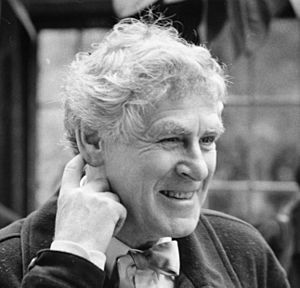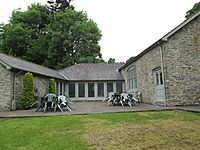James Roose-Evans facts for kids
James Roose-Evans (born November 11, 1927 – died October 26, 2022) was a British theatre director, a priest, and a writer. He was known for his work in experimental theatre, which is about trying new and different ways to perform plays. He also wrote about rituals and meditation. In 1959, he started the Hampstead Theatre Club in London. Later, in 1974, he founded the Bleddfa Centre for the Creative Spirit in Wales. He was most famous for directing the play 84 Charing Cross Road in London's West End.
Contents
Early Life and School Days
James Roose-Evans was born in London on November 11, 1927. He was the second son of Jack and Primrose. His older brother, Monty, later moved to America. James went to the Crypt Grammar School in Gloucester. After school, he spent about a year and a half in the Royal Army Educational Corps, finishing his service in a city called Trieste in 1947.
In 1949, he went to St Benet's Hall, Oxford University to study English. During his holidays and after he graduated, he worked as an actor in different repertory theatres. These theatres put on many different plays. In 1954, while he was the main actor in Bridgwater, Somerset, another actor named Kenneth Williams encouraged him to try directing plays.
Becoming a Theatre Director
In 1954, James Roose-Evans became the Artistic Director of the Maddermarket Theatre in Norwich. In just one season (1954–1955), he directed nine plays. These included William Shakespeare's Macbeth, where he also played the main character. He also directed Dona Rosita by Federico García Lorca. For this play, he even visited Granada to meet the real person the play was about!
After meeting the famous dancer Martha Graham and seeing her dance company perform in England, James decided to go to America. He wanted to learn more about modern dance. He got a job at the Juilliard School of Music in New York City. There, from 1955 to 1956, he had his own studio with dancers, musicians, and a composer. He was able to try out new ways to mix music, dance, and drama together.
Teaching at RADA
When James Roose-Evans came back to the UK, he joined the Royal Academy of Dramatic Art (RADA). This is a very famous drama school. He directed many plays there in the Vanbrugh Theatre. These plays ranged from his own version of Milton's Paradise Lost to Port Royal by Henri de Montherlant. His production of Dylan Thomas's Under Milk Wood was so popular that it was performed again and again with different actors. Eventually, it moved to the Lyric Theatre in Hammersmith, with Philip Madoc playing the main role.
Some of the students James Roose-Evans taught at RADA became very famous. These included Mike Leigh, Sarah Miles, John Hurt, Geoffrey Whitehead, and Michael Williams. He also taught at the Central School of Speech and Drama, where he influenced students like Vanessa Redgrave and Judi Dench.
Starting Hampstead Theatre
In 1959, Roose-Evans started the Hampstead Theatre Club. It was located at Moreland Hall in Holly Bush Vale, London. The first play they showed was Siwan, written by the Welsh poet Saunders Lewis. Siân Phillips played Princess Siwan in this play. The theatre then showed two short plays by Harold Pinter, called The Dumb Waiter and The Room. These plays received amazing reviews from Harold Hobson in The Sunday Times newspaper. This helped the new theatre become well-known in the cultural world.
James Roose-Evans stayed at the Hampstead Theatre until 1971. During this time, his production of Noël Coward's Private Lives moved to the West End. After that, his play based on Laurie Lee's book Cider with Rosie also moved to the West End. At one point, Hampstead Theatre had two plays running in the West End at the same time! During this period, he also started Stage Two, which was a short-lived part of the Hampstead Theatre. It was meant to be a place for trying out experimental theatre ideas.
Directing After 1971
In the years after 1971, James Roose-Evans directed many plays for commercial theatres. These included another production of Private Lives with Joanna Lumley and Simon Cadell. He also directed an experimental version of Oedipus for a Greek theatre in Athens. In 1973, he directed the Chester Mystery Plays, which he rehearsed for nine months.
84 Charing Cross Road
In the summer of 1980, Roose-Evans went to teach a class on Experimental Theatre in Grand Rapids, Michigan, USA. His assistant there, Susan Kruger, gave him a book called 84, Charing Cross Road by Helene Hanff. James liked the book so much that he turned it into a play. He directed the very first performance of the play at the Salisbury Playhouse in the summer of 1981. The play then moved to the West End in London. It won awards for Rosemary Leach as Best Actress and for Roose-Evans as Best Director.
In 1982, he directed an American cast of the play on Broadway in New York City. Ellen Burstyn and Joe Maher played the main characters. This production also won awards for Best Actress, Best Actor, Best Director, and Best Play. James later directed tours of 84 Charing Cross Road with different actresses, including Miriam Karlin and Rula Lenska. In February 2015, his newest production of 84 Charing Cross Road opened in Salisbury with Janie Dee and Clive Francis.
Frontier Theatre Productions
James Roose-Evans was also involved with a new theatre company called Frontier Theatre Productions. This company gives actors who are over 60 years old a chance to perform.
Ritual and Its Meaning
James Roose-Evans was very interested in rituals. These are special actions or ceremonies that people do, often for important moments in life. He was interested in creating new rituals for different situations. His book, Passages of the Soul: Ritual Today, explains his work in this area and the exercises he developed.
Meditation and Spiritual Life
In the early 1960s, James Roose-Evans presented a series of short TV programs for BBC television about prayer. He also wrote a weekly column about meditation for the Church Times newspaper.
James grew up in the Anglican Church. While he was in the army in Trieste, he joined the Roman Catholic Church. Later, he returned to Anglicanism. In 1981, he became a non-stipendiary priest (a priest who doesn't get paid) in the Church of England in Hereford Cathedral.
Roose-Evans practiced meditation for more than fifty years. In his first book on the topic, Inner Journey: Outer Journey, Finding a spiritual centre in everyday life, he wrote that his understanding of prayer came from real-life experience, even when things were uncertain or stressful. He wanted to encourage others to find an inner calm, even in a busy life. His most recent book on meditation is Finding Silence: 52 Meditations for Daily Living. He also wrote a blog called The Sound of Silence.
In 2020, James was invited to Lambeth Palace to receive the Dunstan Award. This award recognized his special work over 65 years in exploring how art and life, and creativity and spirituality, are connected.
The Bleddfa Centre for the Creative Spirit
The Bleddfa Centre, located in Powys, Wales, was started in 1974 by James Roose-Evans and his companion, Hywel Jones. The Bleddfa Centre holds workshops, seminars, and retreats. Its goal is to encourage people to explore the connection between art and life, and between being creative and being spiritual.
Writing for Newspapers and Radio
James Roose-Evans wrote articles and reviews for many different newspapers and magazines. He was a regular guest on the BBC radio programs Kaleidoscope and Woman's Hour. For two years, he wrote a weekly column for Woman magazine called "Something Extra."
Books He Wrote
James Roose-Evans wrote twenty-one books. Some of his well-known books include:
- Directing A Play (with an introduction by Vanessa Redgrave)
- Experimental Theatre
- London Theatre: from the Globe to the National
- One Foot on the Stage (a book about the actor Richard Wilson)
- Inner Journey: Outer Journey
- Passages of the Soul: Ritual Today
- Opening Doors and Windows: A Memoir in Four Acts
- Finding Silence: 52 Meditations for Daily Living
He also edited the letters of Joyce Grenfell to her mother, called Darling Ma. He also edited her wartime journals, The Time of My Life. In addition, he wrote a show about Joyce Grenfell for Maureen Lipman called Re:Joyce!, and he directed its first performances. This show later had two very successful runs in the West End.
James Roose-Evans' important papers and writings are kept at the Harry Ransom Center at the University of Texas at Austin.
Personal Life and Passing
James Roose-Evans shared his life with Hywel Jones for 54 years. Hywel Jones passed away in 2013. James Roose-Evans then wrote a book about their life together.
James Roose-Evans died on October 26, 2022, when he was 94 years old.
More Books by James Roose-Evans
Here are some more books James Roose-Evans wrote:
- Directing a Play (1968)
- Experimental Theatre from Stanislavsky to Peter Brook (1970)
- London Theatre: From the Globe to the National (1977) ISBN: 978-0-7148-1766-8
- Inner Journey: Outer Journey (1987)
- The Cook-a-Story Book
- Passages of the Soul: Ritual Today (1995)
- The Inner Stage: Finding a Centre in Prayer and Ritual (1995) ISBN: 978-1-56101-001-1
- One Foot on the Stage: The Biography of Richard Wilson (1996)
- Cook-a-Story: The Bleddfa Cook Book (2005)
- Opening Doors and Windows A Memoir In Four Acts (2009)
- Finding Silence 52 meditations for Daily Living (2009)
- Blue Remembered Hills: A Radnorshire Journey (2017) ISBN: 978-1-9998-3799-0
- A Life Shared, Port Meadow Press, [2018], ISBN: 978-1-9998379-5-2
- Older: A Thought Diary (2019)
- Behold the Word: 52 Visual Meditations (2020) (with John Rowlands-Pritchard)
He also wrote several books for children, including:
- The Adventures of Odd and Elsewhere (1971)
- The Secret Of The Seven Bright Shiners (1972)
- Elsewhere and the Gathering of the Clowns (1974)
- Odd and the Great Bear (1974)
- The Return Of The Great Bear (1975 May) ISBN: 978-0-233-96647-2
- Odd to the Rescue! (1975)
- The Secret Of Tippity Witchit (1975 October)
- The Lost Treasure of Wales (1977)
- The Christ Mouse
The "Odd and Elsewhere" series of children's books had illustrations by Brian Robb.



